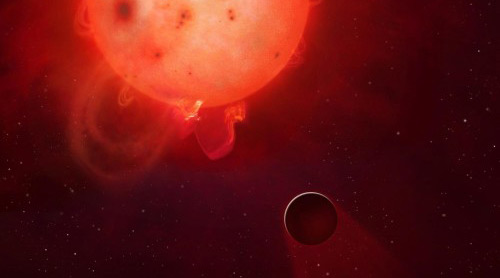
Radioactive? Kepler-438b is regularly irradiated by huge flares of radiation from its host star. (Courtesy: Mark A Garlick/University of Warwick)
By Tushna Commissariat
In the past decade or two, exoplanetary research has been booming as NASA’s Kepler telescope and its cohorts have found nearly 2000 exoplanets and 5000 promising candidates. Unsurprisingly, we have been searching long and hard for those planets that could be habitable or are as similar in shape, size and proximity to the host star as the Earth is to the Sun. Indeed, in January this year Kepler scientists announced that they had found the most Earth-like planet to date – Kepler-438b – orbiting within the habitable zone of its host star, the red dwarf Kepler-438, which lies about 470 light-years from Earth.
The planet, which is slightly bigger than our own, was found to be rocky, and, thanks to its location, rather temperate, meaning that it could have flowing water on it – two key factors that astronomers look for when accessing a planet’s habitability. Unfortunately, David Armstrong of the University of Warwick in the UK and colleagues have now found that Earth’s twin is regularly bathed in vast quantities of radiation from its star – a real dampener when it comes to the formation of life as we known it.
“Unlike the Earth’s relatively quiet Sun, Kepler-438 emits harsh flares every few hundred days, each one stronger than the most powerful recorded flare on the Sun,” says Armstrong, explaining that it is likely that such flares are associated with “coronal mass ejections” – where a huge amount of plasma is hurled outwards from the star – which, in turn, could seriously impact the habitability of the planet.
Kepler-438’s superflares have the equivalent energy to 100 billion megatonnes of TNT. As the planet is similar to Earth, it may also have a magnetic field that could shield it from some of these effects. Although the flares alone would not be too damaging to the planet’s atmosphere, the related coronal mass ejections could potentially have stripped away the atmosphere and laid the planet bare. “With little atmosphere, the planet would also be subjected to harsh UV and X-ray radiation from the superflares, along with charged-particle radiation, all of which are damaging to life,” cautions Armstrong.
So, it seems more than likely that while Kepler-438b is Earth-like at first glance, the chances of any life surviving its regular radiation dose is slim to none, meaning that the search for a truly habitable Earth-twin carries on.
Trackback: Blog – physicsworld.com | Physics
Trackback: Radiation blasts render Earth’s twin inhospitable to life – MyPhysNet